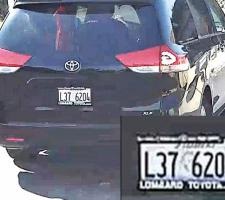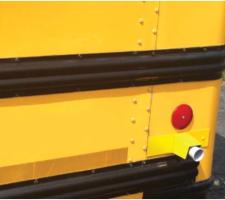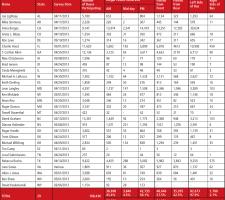
Rear mounted forward-facing HD camera
School authorities in the US are turning to automated school bus stop arm enforcement to curb an astonishing number of violations.
It is estimated that every year nearly 17,000 American children are sent to emergency rooms as a result of school bus related crashes. And when surveyed, 99% of school bus drivers reported that the most dangerous behaviour they encounter is drivers passing a school bus with its stop sign arm extended. Every day these drivers who violate the extended stop arm signs put at risk the lives of almost 26 million students who are simply getting on or off a school bus. Each of the 50 states has legislation that makes it illegal to pass a school bus with its red lights flashing and stop arm extended indicating that it has stopped to load or unload students. While these regulations vary slightly from one state to another, the basics remain constant and a proportion of motorists simply choose to ignore these laws.
In 2013, the National Association of State Directors of Pupil Transportation Services (NASDPTS), www.nasdpts.org, conducted a study of bus drivers from 29 States representing a total of 108,436 buses (www.nasdpts.org/stoparm). Staggeringly this recorded almost 85,300 stop arm violations on a single day – and this figure was consistent with the previous studies conducted by the NASDPTS in 2011 and 2012. Extrapolating these sample results across a 180-day school year points to nearly 15 million stop arm violations by private motorists.
On seeing the stationary bus in the opposing lane these motorists may decide that if no students are crossing the road, then it’s safe to continue. Others driving behind the stopped vehicle may pull into the left lane to go around the bus. And, almost unbelievably, the most dangerous drivers pass the bus on the right side where children are loading or unloading. The 29-state survey recorded 1,780 such offences in a single day – that’s 2.1% of all the violations.
Against that background and in the light of recent student fatalities, many states are starting to adopt the use of more stringent safety countermeasures, including the use of automated school bus stop arm safety cameras. In 2012 alone seven states, including Connecticut, Rhode Island, Mississippi and Washington, joined Texas, North Carolina and Georgia in enacting state legislation authorising the use of stop arm technology.
In 2013 Illinois also authorised the use of stop arm cameras and an estimated 20 more states are expected to pass similar legislation in early 2014. Transportation specialists have predicted that within the next 10 years most, if not all states, will have adopted similar legislation authorising this technology on the grounds that it promotes child safety and enhances police enforcement of existing laws.
The allure of the technology for school districts operating on limited budgets is that it is the only safety solution which can be implemented without any out-of-pocket expenses.7702 RedSpeed USA, the Illinois-based automated enforcement camera provider, offers its turn-key CrossingShield solution without any upfront cost to the district as the installation is 100% violator funded. Similar schemes exist from other providers.
Implementation of the CrossingShield automated stop arm camera system program is straightforward. RedSpeed USA mounts the safety camera system (comprising two high resolution cameras, high definition DVR and an ultrasonic detection sensor) on the front and rear offside of the school bus. Both cameras are positioned at an angle to ensure the extended stop arm is clearly visible in the field of view, strengthening the validity of the evidence package.
The camera system is capable of monitoring up to four lanes of traffic on the driver’s side of the bus, offering bi-directional violation capture and the ability of identifying violations by lane for up to three adjacent lanes. Additionally, under low light conditions, the in-built infrared illumination ensures clear plate images are captured without adversely affecting oncoming cars.
When the bus comes to a halt and the driver deploys the stop arm and amber warning lights, the high definition and video cameras are automatically activated. Removing the need for manual activation allows the driver to remain focused on the safe loading and unloading of students. If a vehicle passes the stopped bus, the sonar sensor is triggered and a system-generated data bar is embedded on the secure and encrypted video data file, and an event flag is logged in the DVR software. The fully use-definable data bar includes the date, time, GPS coordinates and the passing vehicle speed. And when the bus driver retracts the stop arm and deactivates the warning signals, the DVR unit returns to standby mode.
Once the bus returns to the depot, the system automatically connects to a secure wireless network through which the captured videos are uploaded to RedSpeed’s back-office system for review. Trained personnel view the video clip, still images and the vehicle’s registered owner information to confirm the violation is enforceable before sending the electronic evidence package to law enforcement personnel for approval or rejection. Once police approval is received, RedSpeed prints and mails a citation to the vehicle’s registered owner.
Fines associated with stop arm violations vary by state and range from the Illinois $150 penalty up to the $450 violators can face in Connecticut. A common denominator is that the fine for any subsequent violations is considerably higher than the first. In many states repeat offenders may face suspension of their driving privileges.
Surveys conducted by the834 National Highway Traffic Safety Administration show that school bus stop arm violation problems are comprised of three layers. To successfully increase stop arm compliance, a program must address each of the three components.
#1 - The law is not obeyed by motorists as a result of lack of knowledge. Some motorists are not aware of the specifics of the regulations and the consequences for breaking the law.
#2 - Violations are not reported or are under-reported by bus drivers due to lack of information, lack of motivation, lack of procedures or difficulty in establishing a baseline of what constitutes a violation.
#3 - The law is not enforced by police due to an insufficient number of officers available to witness violations and an inability to safely pursue the violator in order to issue the written citation.
Automated stop arm camera enforcement can address each of these areas of concern.
When School Districts distribute information advising the stop arm cameras are being implemented, general awareness surrounding all facets of bus safety is increased and motorists become cognisant of legal and illegal behaviour when passing a stopped school bus.
Research clearly indicates when drivers are aware automated enforcement cameras are being utilised they are less likely to gamble with breaking the law, as the potential to be held accountable is far higher than with traditional enforcement methods. The fact that the system is fully automated, requiring no bus driver involvement, removes the drivers from the enforcement equation. Finally, the technology serves as a police force multiplier, freeing up manpower to focus on other high priority tasks.
For municipalities and school districts considering the use of automated stop arm camera enforcement, the question is simple: If you have the opportunity to install and utilise a camera system at no out of pocket expense, a system which will create a deterrent and be paid for by the motorists choosing to ignore the law and endanger your students…why wouldn’t you?
It is estimated that every year nearly 17,000 American children are sent to emergency rooms as a result of school bus related crashes. And when surveyed, 99% of school bus drivers reported that the most dangerous behaviour they encounter is drivers passing a school bus with its stop sign arm extended. Every day these drivers who violate the extended stop arm signs put at risk the lives of almost 26 million students who are simply getting on or off a school bus. Each of the 50 states has legislation that makes it illegal to pass a school bus with its red lights flashing and stop arm extended indicating that it has stopped to load or unload students. While these regulations vary slightly from one state to another, the basics remain constant and a proportion of motorists simply choose to ignore these laws.
In 2013, the National Association of State Directors of Pupil Transportation Services (NASDPTS), www.nasdpts.org, conducted a study of bus drivers from 29 States representing a total of 108,436 buses (www.nasdpts.org/stoparm). Staggeringly this recorded almost 85,300 stop arm violations on a single day – and this figure was consistent with the previous studies conducted by the NASDPTS in 2011 and 2012. Extrapolating these sample results across a 180-day school year points to nearly 15 million stop arm violations by private motorists.
On seeing the stationary bus in the opposing lane these motorists may decide that if no students are crossing the road, then it’s safe to continue. Others driving behind the stopped vehicle may pull into the left lane to go around the bus. And, almost unbelievably, the most dangerous drivers pass the bus on the right side where children are loading or unloading. The 29-state survey recorded 1,780 such offences in a single day – that’s 2.1% of all the violations.
Against that background and in the light of recent student fatalities, many states are starting to adopt the use of more stringent safety countermeasures, including the use of automated school bus stop arm safety cameras. In 2012 alone seven states, including Connecticut, Rhode Island, Mississippi and Washington, joined Texas, North Carolina and Georgia in enacting state legislation authorising the use of stop arm technology.
In 2013 Illinois also authorised the use of stop arm cameras and an estimated 20 more states are expected to pass similar legislation in early 2014. Transportation specialists have predicted that within the next 10 years most, if not all states, will have adopted similar legislation authorising this technology on the grounds that it promotes child safety and enhances police enforcement of existing laws.
The allure of the technology for school districts operating on limited budgets is that it is the only safety solution which can be implemented without any out-of-pocket expenses.
Implementation of the CrossingShield automated stop arm camera system program is straightforward. RedSpeed USA mounts the safety camera system (comprising two high resolution cameras, high definition DVR and an ultrasonic detection sensor) on the front and rear offside of the school bus. Both cameras are positioned at an angle to ensure the extended stop arm is clearly visible in the field of view, strengthening the validity of the evidence package.
The camera system is capable of monitoring up to four lanes of traffic on the driver’s side of the bus, offering bi-directional violation capture and the ability of identifying violations by lane for up to three adjacent lanes. Additionally, under low light conditions, the in-built infrared illumination ensures clear plate images are captured without adversely affecting oncoming cars.
When the bus comes to a halt and the driver deploys the stop arm and amber warning lights, the high definition and video cameras are automatically activated. Removing the need for manual activation allows the driver to remain focused on the safe loading and unloading of students. If a vehicle passes the stopped bus, the sonar sensor is triggered and a system-generated data bar is embedded on the secure and encrypted video data file, and an event flag is logged in the DVR software. The fully use-definable data bar includes the date, time, GPS coordinates and the passing vehicle speed. And when the bus driver retracts the stop arm and deactivates the warning signals, the DVR unit returns to standby mode.
Once the bus returns to the depot, the system automatically connects to a secure wireless network through which the captured videos are uploaded to RedSpeed’s back-office system for review. Trained personnel view the video clip, still images and the vehicle’s registered owner information to confirm the violation is enforceable before sending the electronic evidence package to law enforcement personnel for approval or rejection. Once police approval is received, RedSpeed prints and mails a citation to the vehicle’s registered owner.
Fines associated with stop arm violations vary by state and range from the Illinois $150 penalty up to the $450 violators can face in Connecticut. A common denominator is that the fine for any subsequent violations is considerably higher than the first. In many states repeat offenders may face suspension of their driving privileges.
Surveys conducted by the
#1 - The law is not obeyed by motorists as a result of lack of knowledge. Some motorists are not aware of the specifics of the regulations and the consequences for breaking the law.
#2 - Violations are not reported or are under-reported by bus drivers due to lack of information, lack of motivation, lack of procedures or difficulty in establishing a baseline of what constitutes a violation.
#3 - The law is not enforced by police due to an insufficient number of officers available to witness violations and an inability to safely pursue the violator in order to issue the written citation.
Automated stop arm camera enforcement can address each of these areas of concern.
When School Districts distribute information advising the stop arm cameras are being implemented, general awareness surrounding all facets of bus safety is increased and motorists become cognisant of legal and illegal behaviour when passing a stopped school bus.
Research clearly indicates when drivers are aware automated enforcement cameras are being utilised they are less likely to gamble with breaking the law, as the potential to be held accountable is far higher than with traditional enforcement methods. The fact that the system is fully automated, requiring no bus driver involvement, removes the drivers from the enforcement equation. Finally, the technology serves as a police force multiplier, freeing up manpower to focus on other high priority tasks.
For municipalities and school districts considering the use of automated stop arm camera enforcement, the question is simple: If you have the opportunity to install and utilise a camera system at no out of pocket expense, a system which will create a deterrent and be paid for by the motorists choosing to ignore the law and endanger your students…why wouldn’t you?















